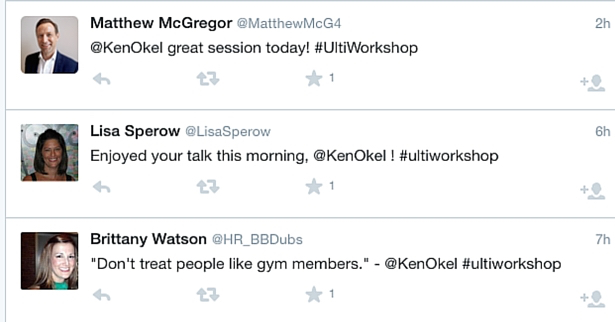
Leaders, who eagerly want to find new ways to improve employee innovation, often miss a very simple principle. Promoting and putting new ideas into practice requires time to think. The mistake is believing this kind of change is an instant process, much like oatmeal or rice.
From my speaking presentations, I’ve discovered the audience needs time to process what they’re learning. During a 45 to 90 minute keynote, I’ll schedule one or two roughly five minute breaks.
I stop talking and ask the audience to turn to the person next to them. Their mission is to discuss a takeaway they can use when they return to the office.
While it’s tempting to skip this step and just give out more information from the stage, learning can’t be a one way process. I’ve found having people take a moment to think about implementation, increases comprehension and followup.
Similar processes can also help other aspects of employee innovation:
Conference Learning and ROI
Imagine a member of your team goes to a conference, takes lots of notes, and then comes back to your office full of ideas. The problem is day-to-day demands prevent any of the ideas from ever getting out of the notebook.
Your business won’t succeed based on notes kept on a dusty shelf. When the person comes back from the event, give him or her some time to organize the top takeaways.
Then that person will lead a presentation of the ideas and a discussion needs to happen about whether they can be turned into action steps.
Questions to Help Improve Employee Innovation
Change can be difficult and new ideas may encounter resistance. I’ve found these are important questions to discuss:
- “Why are we considering this new idea?”
- “What happens if we do nothing?”
- “How do we scale this idea to make it fit our business?”
- “If we implement this idea, how will things change in one year?”
Innovation May Require Explanation
While you may have been dazzled by seeing a new idea put into practice, those who weren’t there may not understand its value. It’s like the difference between experiencing a live performance and hearing a recording.
When you talk about something new, paint a verbal picture that allows other to experience it. Tell them what they are seeing and why it is important.
For instance, a basic description of an assembly line may not excite people because it involves a major change. But if you explain it in such a way that they can understand the efficiency, speed, and precision gained through the manufacturing process, then the buy-in can increase dramatically.






